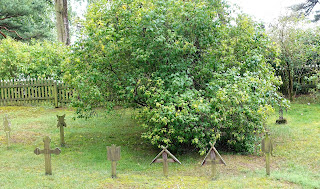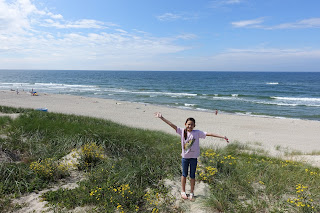Wood crosses in a church cemetery on the Curonian Spit
Being relatively new to Lithuania (only three months), we're often warned that winters here will be cold, dark and dreary (Vilnius allegedly only has 70 clear, sunny days a year), and that it would be best to fly to a sunny locale for some rest and recreation in order to get more than the 6-7 hours of daylight we'll soon be receiving here. Seeing as my wife wants to visit Finland or Norway during the colder months to try and see the northern lights, a winter beach getaway isn't an option. Which is why I took a look at the calendar, and realizing that summer is going to be over soon, decided we should try and squeeze in an ocean sojourn before it became too late. In Lithuania that means the Baltic Sea, and one of the best places to experience the sun, sand and surf (not the sport, just the crashing waves) is the Curonian Spit National Park (Kuršių Nerijos Nacionalinis Parkas).
The park was established in 1991 in order to protect the sand dunes there (the Curonian Spit became a UNESCO World Heritage Site in 2000). The spit is just that, a long, narrow strip of land separating the Baltic Sea in the west from the freshwater Curonian Lagoon to the east, and shared by Lithuania and the Russian enclave of Kaliningrad. The Lithuanian portion of the strip runs about 50 kilometers (31 miles) from the village of Smiltynė in the north to Nida in the south. Pine forests cover 70% of the national park's land area, with sand dunes making up another 25%. The permanent population of just 3100 is mainly concentrated in four small villages - Juodkrantė, Pervalka, Preila and Nida - that are collectively known as Neringa. Most of the spit was historically German territory until it was annexed by Lithuania in 1923, and virtually all of the German-speaking residents were driven out by the Red Army at the end of World War II and replaced by Russians in an act of ethnic cleansing. This historical legacy attracts a large number of German tourists these days to the spit, and many signs and restaurant menus are in German (as well as Lithuanian, Russian and English).
We three Americans left Vilnius on a Wednesday afternoon for the four hour-plus drive to Nida, driving on the A1 highway which connects the capital to the port city of Klaipeda. It's a straightforward 300 kilometer (190 miles)-long drive, with plenty of gas stations and restaurants along the way. The maximum speed limit is 130 kph (81 mph), and in a refreshing change of pace, virtually every driver seems to understand the concept of fast and slow lanes (I'm talking to you Taiwan!). From Klaipeda, it's a short hop aboard a car ferry to the spit:
We reached our hotel in Nida at around half past six, then finished off the day with dinner in town:
Our home-away-from-home from Wednesday evening to Sunday morning was the Miško Namas guesthouse, decked out in the typical blue-and-white of Curonian homes. Our room was actually a small apartment which included a fully-equipped kitchen and a balcony:
Thursday started off on a drizzly note, and rain would be a constant presence during out time on the spit, though fortunately it let up often enough that we were actually able to get out and do things, like visiting the Amber Gallery (Gintaro Galerija). The Baltic region is home to the world's largest collection of amber (though not the one pictured above), and the gallery does a good job explaining the how's and why's of Baltic amber. Some of the jewelry pieces on display were stunning, but authenticity and quality carry a hefty price tag, however, so we didn't purchase any souvenirs there:
Morning on the Curonian Lagoon:
The Evangelical-Lutheran Church dates from 1888. It's German heritage makes it a popular stop for German tour groups:
The adjoining cemetery has some good examples of krikstai - wooden crosses meant to help the dead on their ascent to heaven:
Behind the cemetery is a sign indicating the start of a nine kilometer (5.6 miles)-long loop trail around Nida. Shu-E knew what was coming, and quickly announced she would be relaxing back at the guesthouse, but Amber didn't have a chance and soon the two of us were walking through the forest:
The path took us across the spit, where we got our feet wet in the Baltic Sea:
Then it was back into the forest, where the weather suddenly took an ominous turn. It wasn't long before the rain came pouring down, leaving us pretty soaked despite our umbrellas:
The storm eventually passed over us and continued out into the Curonian Lagoon...:
...only to be quickly replaced by another cloudburst coming in from the Baltic Sea:
The end of the path found the two of us accumulating sand on the lower halves of our bodies as we trudged along the lagoon-facing side of the Parnidis Dune (more on this landmark in the next blog post). It was with some relief when we finally made our way down from the dune and headed back toward Nida:
After cleaning ourselves off at the guesthouse, my daughter and I regaled my wife with tales of the day's adventures over dinner at Grill House'as. The woman sitting behind us seemed less than impressed:
Laukite tęsinio...























No comments:
Post a Comment